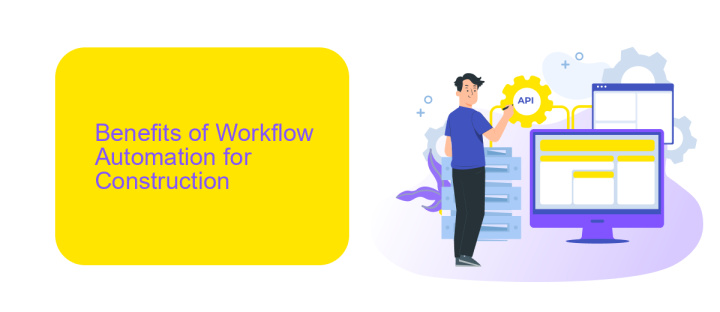Workflow Automation Construction
Workflow automation in construction is revolutionizing the industry by streamlining processes, reducing manual errors, and enhancing productivity. By integrating advanced technologies such as AI, IoT, and cloud computing, construction firms can automate repetitive tasks, improve project management, and ensure timely completion of projects. This article explores the key benefits and practical applications of workflow automation in the construction sector.
Introduction to Workflow Automation in Construction
Workflow automation in construction is transforming the industry by streamlining processes, reducing manual labor, and enhancing overall efficiency. With the integration of advanced technologies, construction projects can now be managed more effectively, ensuring timely completion and cost savings. Automation tools are becoming essential for project managers and teams to handle complex workflows seamlessly.
- Improved task management and scheduling
- Enhanced communication and collaboration
- Real-time data tracking and reporting
- Reduced human error and increased accuracy
- Integration with other software and tools
One of the key aspects of workflow automation is the ability to integrate various tools and services. Platforms like ApiX-Drive facilitate these integrations, allowing construction teams to connect different software applications without extensive coding knowledge. This ensures a smoother workflow, where data flows seamlessly between systems, enhancing productivity and project outcomes. By leveraging such automation solutions, the construction industry can achieve greater efficiency and innovation.
Benefits of Workflow Automation for Construction

Workflow automation in construction significantly enhances efficiency by streamlining repetitive tasks and reducing manual errors. Automated systems can handle scheduling, resource allocation, and progress tracking, allowing project managers to focus on more strategic activities. This leads to faster project completion times and reduced costs, as fewer resources are wasted on redundant processes. Additionally, automation improves communication and collaboration among team members, ensuring that everyone is on the same page and that project information is always up-to-date.
Integrating various tools and software through services like ApiX-Drive further amplifies the benefits of workflow automation. ApiX-Drive allows seamless integration of different applications, enabling data to flow effortlessly between systems. This ensures that all stakeholders have access to real-time information, reducing the chances of miscommunication and delays. By automating data entry and synchronization, construction teams can maintain a higher level of accuracy and consistency across all project phases, ultimately leading to better project outcomes and client satisfaction.
Key Features and Considerations for Workflow Automation

Workflow automation optimizes business processes by reducing manual effort and increasing efficiency. When constructing an automated workflow, it is essential to consider several key features and factors to ensure smooth operation and integration.
- Scalability: Ensure the system can grow with your business needs.
- Integration Capabilities: Utilize services like ApiX-Drive to seamlessly connect various applications and systems.
- User-Friendly Interface: A straightforward interface helps users adapt quickly.
- Security: Implement robust security measures to protect sensitive data.
- Customizability: The ability to tailor workflows to specific business requirements is crucial.
- Real-Time Monitoring: Track workflow performance and identify bottlenecks in real-time.
Considering these features and factors will help you build a robust and efficient workflow automation system. Leveraging tools like ApiX-Drive can significantly enhance integration capabilities, ensuring seamless data flow between different applications and services. This holistic approach will ultimately lead to improved productivity and operational efficiency.
Implementation and Integration of Workflow Automation

Implementing workflow automation begins with a thorough analysis of existing processes. Identify repetitive tasks and assess their potential for automation. This initial step ensures that the automation strategy aligns with the organization's goals and enhances overall efficiency.
Integration is a critical component of workflow automation. Seamlessly connecting various tools and systems is essential for a smooth operation. Platforms like ApiX-Drive facilitate this by offering robust integration capabilities, allowing different applications to communicate effectively without extensive manual intervention.
- Identify key processes suitable for automation
- Select appropriate automation tools and platforms
- Utilize integration services like ApiX-Drive for seamless connectivity
- Test and refine automated workflows for optimal performance
Once the integration is complete, continuous monitoring and optimization are vital. Regularly review automated workflows to ensure they meet the desired objectives and adapt them as necessary. This proactive approach helps maintain efficiency and addresses any emerging challenges promptly.
Best Practices for Successful Workflow Automation in Construction
Implementing workflow automation in construction requires a strategic approach to ensure efficiency and effectiveness. Begin by thoroughly analyzing existing workflows to identify bottlenecks and repetitive tasks that can be automated. Engage with stakeholders, including project managers, engineers, and on-site workers, to gather insights and ensure that the automation aligns with their needs. Documenting current processes will help in creating a clear roadmap for automation.
Choosing the right tools and platforms is crucial for successful automation. Opt for flexible and scalable solutions that can integrate seamlessly with your existing systems. Services like ApiX-Drive facilitate easy integration of various applications, ensuring smooth data flow between different tools. Regularly monitor and evaluate the automated workflows to identify areas for improvement. Training employees on new systems and encouraging feedback will foster a culture of continuous improvement, ensuring long-term success in workflow automation.
FAQ
What is workflow automation in construction?
How can workflow automation benefit construction projects?
What types of processes can be automated in construction?
How difficult is it to implement workflow automation in a construction company?
What should be considered when choosing a workflow automation tool for construction?
Do you want to achieve your goals in business, career and life faster and better? Do it with ApiX-Drive – a tool that will remove a significant part of the routine from workflows and free up additional time to achieve your goals. Test the capabilities of Apix-Drive for free – see for yourself the effectiveness of the tool.

